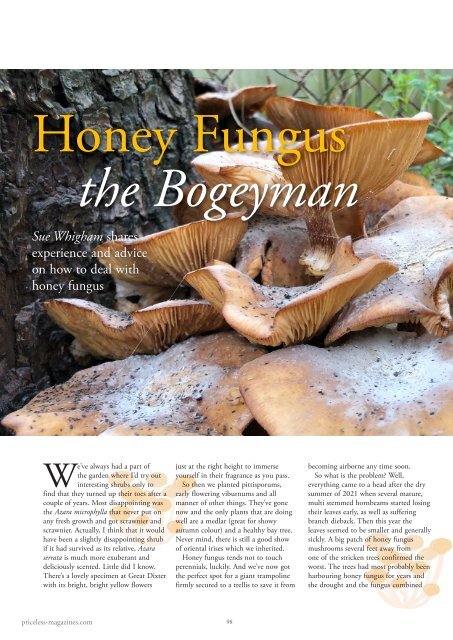Wealden Times | WT260 | January 2024 | Good Living Supplement inside
The lifestyle magazine for Kent & Sussex - Inspirational Interiors, Fabulous Fashion, Delicious Dishes
The lifestyle magazine for Kent & Sussex - Inspirational Interiors, Fabulous Fashion, Delicious Dishes
Create successful ePaper yourself
Turn your PDF publications into a flip-book with our unique Google optimized e-Paper software.
Honey Fungus<br />
the Bogeyman<br />
Sue Whigham shares<br />
experience and advice<br />
on how to deal with<br />
honey fungus<br />
We’ve always had a part of<br />
the garden where I’d try out<br />
interesting shrubs only to<br />
find that they turned up their toes after a<br />
couple of years. Most disappointing was<br />
the Azara microphylla that never put on<br />
any fresh growth and got scrawnier and<br />
scrawnier. Actually, I think that it would<br />
have been a slightly disappointing shrub<br />
if it had survived as its relative, Azara<br />
serrata is much more exuberant and<br />
deliciously scented. Little did I know.<br />
There’s a lovely specimen at Great Dixter<br />
with its bright, bright yellow flowers<br />
just at the right height to immerse<br />
yourself in their fragrance as you pass.<br />
So then we planted pittisporums,<br />
early flowering viburnums and all<br />
manner of other things. They’ve gone<br />
now and the only plants that are doing<br />
well are a medlar (great for showy<br />
autumn colour) and a healthy bay tree.<br />
Never mind, there is still a good show<br />
of oriental irises which we inherited.<br />
Honey fungus tends not to touch<br />
perennials, luckily. And we’ve now got<br />
the perfect spot for a giant trampoline<br />
firmly secured to a trellis to save it from<br />
becoming airborne any time soon.<br />
So what is the problem? Well,<br />
everything came to a head after the dry<br />
summer of 2021 when several mature,<br />
multi stemmed hornbeams started losing<br />
their leaves early, as well as suffering<br />
branch dieback. Then this year the<br />
leaves seemed to be smaller and generally<br />
sickly. A big patch of honey fungus<br />
mushrooms several feet away from<br />
one of the stricken trees confirmed the<br />
worst. The trees had most probably been<br />
harbouring honey fungus for years and<br />
the drought and the fungus combined<br />
priceless-magazines.com 98

















